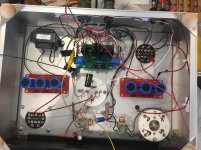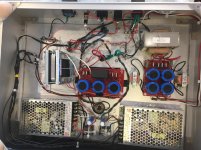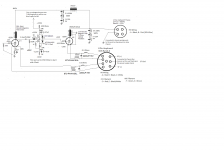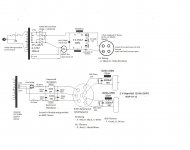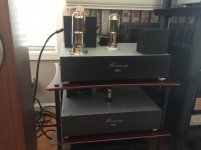Hi I just finished a 805 A2 amplifier with 211 as a driver with a mosfet source follower. These are mono-blocks, with 2 chassis per monoblock, one for power supply and one for the amp. Attached are the schematics and internal construction pictures. The plate chokes and output transformer is from Monolith Magnetics, chassis is from Landfall, power transformer is Heyboer -- all great folks to work with! Amazing sound that is effortless, with deep and wide soundstage. This replaces my 811A amp that used similar source follower circuit and meanwells for the filament supply with 6E5P as the driver
Thx
Sridhar
Thx
Sridhar
Attachments
Very interesting design and amplifier. I am currently looking to find the best way to drive the 805 in A2.
I don’t understand how to put all the pieces together, but trying to learn. Can you elaborate on the choice of the 211 and the driver circuit?
Peter.
I don’t understand how to put all the pieces together, but trying to learn. Can you elaborate on the choice of the 211 and the driver circuit?
Peter.
The choice of 211 is purely hedonistic 🙂, I have always been wanting to build an amp with a power tube as a driver. I don't think you need that at all. You can do a similar two stage with a high gain tubes and constant current plate load and cap coupled to the mosfet source follower. Tubes I would have used if I went that route to build are
- triode connected C3g
- triode connected 6E5P
- Triode connected 7788
- Triode connected C3m -- may need a preamp
- 5687 -- may need a preamp
- etc
thanks
- triode connected C3g
- triode connected 6E5P
- Triode connected 7788
- Triode connected C3m -- may need a preamp
- 5687 -- may need a preamp
- etc
thanks
I started with the 7788 and ended up with the 6E5P, 7788 was hard to tame, 6E5P worked well and very neutral. I used the Monolith IT to drive a GM70 into A2The choice of 211 is purely hedonistic 🙂, I have always been wanting to build an amp with a power tube as a driver. <snip>
The 805 I used are NOS Amprex with a top cap. I do have PSVane 805 without the top cap, not tried them out yet
I use 6E5P in the 811A class A2 amp, similar circuit as 805. It was the predecessor to the 805 amplifier.
For 7788, I connect G2 and G3 to plate with 1K carbon comp grid stoppers, so far that seem to have stablized. I agree, 6E5P is an excellent and easy choice
I use 6E5P in the 811A class A2 amp, similar circuit as 805. It was the predecessor to the 805 amplifier.
For 7788, I connect G2 and G3 to plate with 1K carbon comp grid stoppers, so far that seem to have stablized. I agree, 6E5P is an excellent and easy choice
I meant to ask you where you find those aluminum bases at your tubes. Its a nice touch, very nice build BTW!
The chassis are custom made by Landfall Systems in Dallas. Super nice folks, even do the CAD drawings for you.
They are my go to guys for the chassis now
They are my go to guys for the chassis now
I used the same guys for my GM70 amps and 01a preamps. Sent them my cadd files which made assembly a piece of cake. I was talking about the alum base of the 811a
I started with the 7788 and ended up with the 6E5P, 7788 was hard to tame, 6E5P worked well and very neutral. I used the Monolith IT to drive a GM70 into A2
How many watts you get from GM70 Class A2? Thank you.
From memory, I think 60 watts, its about like a Cary 805C using a 211How many watts you get from GM70 Class A2? Thank you.
I believe around 22-24w in class A
Its been a few years since I measured it....
Nice. Thanks. I will start my GM70 A2 direct coupling SE AMP in a few weeks, hope that I can get a low noise high Pout AMP then 😛
Have a nice day.
Have a nice day.
I am currently looking to find the best way to drive the 805 in A2.
Peter.
These days, there is no better choice than a power MOSFET source follower, especially for these RF power triodes that pull some major grid currents. It's not so much of a problem for power pents in Class *2 as the grid currents are a good deal less -- about an order in magnitude -- so a cathode follower grid driver isn't overloaded.
Power MOSFETs have rd(on) ratings of single digit ohms, so current sourcing won't be a problem. Being such inherently high gain devices, the Zo of the source follower is quite small, making for less distortion when it has to source currents into +vgk (Zo is of no consequence when current isn't flowing).
There is also the new 805A by PSvane, Shuguang, Acme and Cossor (are they all from the same manufacturer?) No anode cap to worry about 😉
I haven’t seen many reviews of amps using these tubes.
I do I go about creating/using a MOSFET source follower? Is there a basic design that I can use and how do I properly select the components?
The 6E5P-I, mosfet source follower, 805A combo would be interesting.
Peter
I haven’t seen many reviews of amps using these tubes.
I do I go about creating/using a MOSFET source follower? Is there a basic design that I can use and how do I properly select the components?
The 6E5P-I, mosfet source follower, 805A combo would be interesting.
Peter
^
|
See this: MOSFET Follies, half way down the page, there is a description. The design isn't difficult since solid state can be designed from formulas, not loadlines. Since these are inherently high gain devices, it really doesn't matter much which particular transistor you use, provided it can handle the signal frequencies of interest.
For source follower duty, what you want to see is a low Crt spec, as this capacitance becomes your input capacitance. In follower duty, Ci is bootstrapped to a very low value.
|
See this: MOSFET Follies, half way down the page, there is a description. The design isn't difficult since solid state can be designed from formulas, not loadlines. Since these are inherently high gain devices, it really doesn't matter much which particular transistor you use, provided it can handle the signal frequencies of interest.
For source follower duty, what you want to see is a low Crt spec, as this capacitance becomes your input capacitance. In follower duty, Ci is bootstrapped to a very low value.
^
|
See this: MOSFET Follies, half way down the page, there is a description. The design isn't difficult since solid state can be designed from formulas, not loadlines. Since these are inherently high gain devices, it really doesn't matter much which particular transistor you use, provided it can handle the signal frequencies of interest.
For source follower duty, what you want to see is a low Crt spec, as this capacitance becomes your input capacitance. In follower duty, Ci is bootstrapped to a very low value.
Thanks Miles!
I will take the time to read and understand the concepts. I have a tendency to over complicate things and my mind goes all over the place, losing focus on the basics. Maybe an undiagnosed ADD.
- Status
- Not open for further replies.
- Home
- Amplifiers
- Tubes / Valves
- 805 Class A2 Amp
